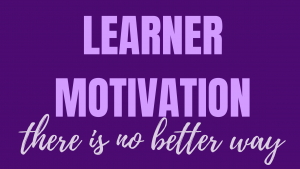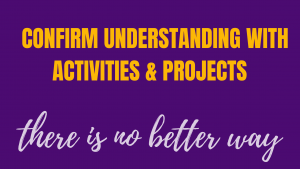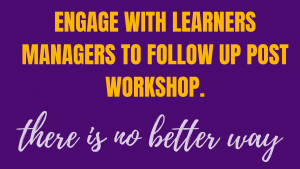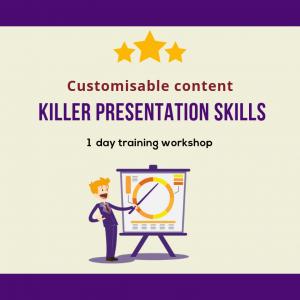Where are we going most wrong?
Where can learning and development professionals best target their efforts to make a to their learners and business today?
Let’s take a moment to consider typical learning environments. Often training requests are reactive, resources can be limited, often learning teams are so busy training others, that reviewing, improving and ensuring targeted learning gets missed.
| Typical learning | Better learning |
| Content-focused | Performance focused |
| Easy to deploy. Standardised or generic training materials | Meaningful for learners |
| Attendance driven | Engagement driven |
| Knowledge delivery – facts driven | Authentic contexts to make facts meaningful |
| Fact testing | Realistic decisions |
| Didactic feedback | Real world consequences |
| One time event | Part of larger professional development intervention and practise |
| One size fits all | Contextualised learning |
Some workplaces are better at delivery targeted learning than others. Perfection is not the goal, however engaging learners, increasing skill capability and demonstrating a return on investment is something that all learning teams should be working towards.
Effective workplace learning programs help your organization achieve two main goals,
- they meet the needs of the organization
- improve employees’ abilities to do their jobs.
According to Forbes, it’s time to focus on real-time learning that’s relevant to employees’ current roles, and turn away from generic, short-term seminars that aren’t directly related to business needs or workers.
Instead of thinking of training and development as something that workers earn the right to after spending years with the organization, it’s important that businesses embrace continuous employee learning at every level. Harvard Business Review reports that programs that focus on employees’ strengths can boost energy and wellness and create the context for higher engagement and learning.
Think Processes, Not Events
Forbes reports that a one-day training seminar, or bringing in a guru to teach an entire team new techniques is rarely effective. According to Forbes, this practice is ineffective for several reasons. People forget what they learn, don’t get to apply it or get sucked back into the day to day, And let’s face it, it is easier to go back to what you know, rather than taking time and the learning pain associated with revisiting the techniques and application. Instead of investing in one-day learning events, it is important to extend the learning by ensuring that practice and feedback is applied via mentoring and coaching for long-term sustainable results.
Have you determined the right objectives in the first place? Without consulting and reviewing business goals, chances are you are developing learning solutions that aren’t going to meet the need.
Ask Employees for Input and Feedback
An integrated learning program can better meet the needs of employees if their voice is incorporated into the process. Businesses are achieving this goal in a variety of ways, including simply asking what employees want to learn through surveys or during reviews. Often, an employee knows better than anyone what they need to improve their job performance, such as better statistical skills or knowledge about an upcoming trend in their field. For example, a software programmer identifying the next language they need to know. Employee feedback can help businesses invest in the right areas for further development. Utilise their insight to create meaningful scenarios, case studies and importantly, context. Those that are consulted ‘own the content’ and will champion for the training.

What’s in it for the learner? (WIIFM)
You might not be helping learners understand why they should care.
Are you missing out on developing motivation?
- Making it meaningful?
- Did you create a communication plan, to warm up your learners?
- Did you sell to them the benefits of attending, what problems it would solve for them?
- Or did they just receive a generic email telling them that they were scheduled to attend training?
Context is everything. If you are getting your communications right, you will have employees actively wanting to know when they can attend.
Are you be asking for learners to recite knowledge back to us instead of applying it. Create learning activities where learners can demonstrate understanding. Even better is to work within the organisation to identify projects or initiatives that learners can join, and actively apply learning to a real-world experience.
Use Simulations
Simulations mimic real-life events. Simulations have the benefit of immersing learners into the topics you are teaching. For example, Learning about stocks takes on a new meaning when students are involved in a Stock Market Game where they ‘buy and sell’ real stocks and maintain a portfolio over the course of the program.
And we might be giving them simple feedback like “right” and “wrong” instead of providing them first with the consequences of their actions. Utilising ‘war stories’ or storytelling and consequences are far more rememberable than simple facts. For example, if conducting training on the topic of health and safety, utilising an example of what happened when procedures were not followed. This could be a recent event in your workplace, on the news, or case study. This enables ensuring that the alternatives represent some real ways people go wrong, and providing feedback that addresses those specific misconceptions.
And, of course, we might not be individualizing the challenges. We could be adapting to demonstrated learner capability. Are we? Are you assessing the skills levels of learners pre-workshop, and again, post-workshop? No one likes to be told information that they already know.
Make time to reflect on our learning and development
Genuine learning is only half achieved through the experience itself. The other half maybe even more challenging to make happen… because it requires that we pause, take a breath, and reflect upon what’s occurred.
Learners need to pause… to put the knowledge gained into practice
Not only might one or more of these be the biggest contributor to a lack of learning impact, but some might be more challenging than others to address. The development activity transforms into useful learning only when it is integrated with what learners already know and do… when they find a place for it to play out through their heads, hearts, and hands.
Going from knowing about something to really growing and developing requires a pause. New ideas, new approaches, new skills all need some space to settle into the scheme of what is already known and done.
One way to start a positive movement towards embedding learning is by engaging with your learner’s managers. Get them involved so they get ‘bang for their learning buck.’ To do this, the manager can utilise the following 5 questions to revisit the learning of their team members.
Questions could be sent to the learners prior to a one on one meeting, coaching session, or if multiple team members attended, the questions could be answered as a collective at a team meeting.
1. What did I discover about myself?
Learning is a process of self-discovery. Gaining a greater understanding of strengths, weaknesses, biases, preferences, and approaches creates a solid foundation for growth and performance.
-
What did I find easiest and most challenging… and what does that mean?
Consciously considering the content or experience from this standpoint provides powerful insights into current capacity and areas that may be most important to explore for development.
-
What three to five ideas will most dramatically enhance my performance and results?
New knowledge must be translated to actions for it to be productive. But too much of a good thing isn’t! Leaving a workshop with 20 ideas to implement is a guarantee that nothing will happen. Identifying just a few high-impact actions generates early results and the momentum to continue to put forth effort.
-
How might I broaden what I’ve learned to different contexts?
Using a new skill as it was taught is great. But finding ways to use that skill in different ways, with different customers, under different conditions… that takes learning to a whole new level.
-
Who would benefit from me sharing what I’ve learned?
Teaching someone else what we know is a powerful way to seal the learning while cementing individual commitment to it in the future. As organizations increase their training budgets and invest more heavily in the development of staff members, let’s remember to build in that final step to ensure that knowing becomes growing.
Your turn: What suggestions do you have for putting knowledge gained from learning and development activities into practice? What areas do you focus on to bring greater value and quality to the training that you deliver?
Facilitated Training has the solution that you need. Editable training materials that can be used again and again. Insert your company logo, add in case studies or examples from your workplace, or train using the quality training materials, as is.
Facilitated Training is your one-stop-shop for world-class, customisable training and professional development resources.
Facilitated Training offers training and organisational development resources to facilitators, trainers, coaches, HR managers and individuals.
Specialising in customisable leadership and management skills, Facilitated Training features a wide variety of products, including Training resources, Professional development courses, assessments, ebooks, videos and more.
Click here for customisable training materials that will assist your workplace in managing resources and output.
www.facilitatedtraining.com
About Facilitated Training’s founder and Chief Learning Officer: Colleen Condon
Colleen Condon is one of Asia Pac’s most well-rounded Organisational and Learning professionals. With her finger in every piece of the Human Resources pie, Colleen has trained 1000s of people across multiple industries and countries. She has conducted training department reviews in Soul, facilitated regional planning programs in Mumbai, deployed leadership programs across Australia, Singapore and New Zealand, to name a few.
She has developed targeted training materials for the likes of Westpac Bank, Bank of Melbourne, Sodexo, Repco and CGU Insurance. Along the way, she has written books for learning and development professionals, implemented regional online induction programs for 14 countries, and most importantly, wielded Flipchart Markers like no one else on Earth.
Colleen commenced her Learning and Development career, along the way she supplemented her practical know-how with a Grad Dip, Vocational Training (Melbourne University 1996) and Masters Educational Leadership (RMIT 2001). Her passion for the ongoing development of herself and others has included accreditation’s in Cultural Orientation Indicator (2015), People Centre Implementation (PCI) 2001, Human Synergistics, Life Style Inventory, and Myers Briggs Indicator Step ii (2004).
Most recently, Colleen was a Director of Learning Development, Asia Pacific, overseeing the development of 64,000 employees.
Her global and regional responsibilities honed her ability to work and create training materials that are adaptable across industry and culture.
But she is not done yet.
Colleen’s passion is to bring engaging and lively adult centred learning to the workplace. Relevant, gamified, outcome-focused Colleen, and her team have created a range of resources that are ready to use. All of the hard work has been done, leaving you to be able to focus on getting on and developing your people.



